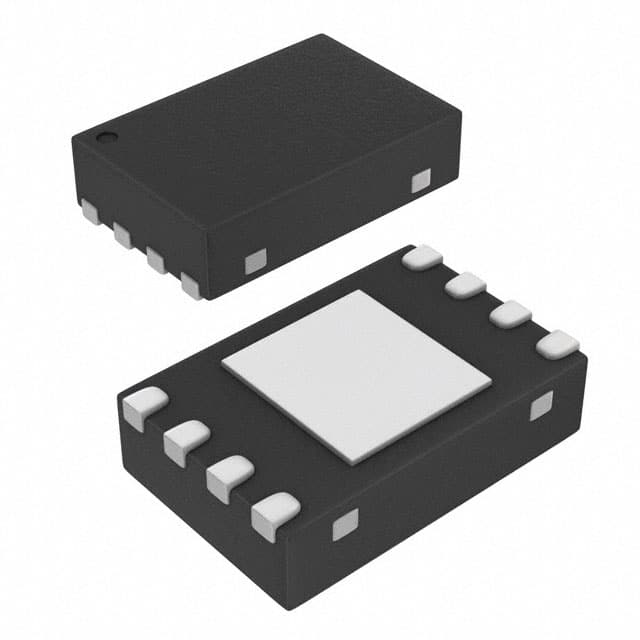PCA9517ATP,147
Product Overview
- Category: Integrated Circuit
- Use: Level Translators
- Characteristics:
- Bidirectional voltage level translation
- Supports I2C and SMBus protocols
- Compatible with 2.5V, 3.3V, and 5V systems
- Low standby current consumption
- Package: TSSOP-8
- Essence: Voltage level shifting for communication between devices operating at different voltage levels.
- Packaging/Quantity: Tape and Reel, 2500 units per reel.
Specifications
- Supply Voltage: 1.65V to 5.5V
- Operating Temperature Range: -40°C to +85°C
- Input High Voltage (VIH): 0.7 x VDD to VDD + 0.5V
- Input Low Voltage (VIL): -0.5V to 0.3 x VDD
- Output High Voltage (VOH): VDD - 0.4V
- Output Low Voltage (VOL): 0.4V
Pin Configuration
The PCA9517ATP,147 has a total of 8 pins arranged as follows:
___________
SDA | 1 8 | VCC
SCL | 2 7 | OE#
GND | 3 6 | SDAOUT
GND | 4 5 | SCLIN
-----------
Functional Features
- Bidirectional voltage level translation between two I2C buses operating at different voltage levels.
- Automatic direction sensing and control.
- Provides bidirectional buffering and level shifting for clock (SCL) and data (SDA) lines.
- Supports I2C and SMBus protocols.
- Low standby current consumption, suitable for battery-powered applications.
Advantages and Disadvantages
Advantages: - Enables communication between devices operating at different voltage levels. - Automatic direction sensing simplifies system design. - Supports popular I2C and SMBus protocols. - Low power consumption extends battery life.
Disadvantages: - Limited to voltage level translation and does not provide other functionalities. - May introduce additional propagation delay in the communication bus.
Working Principles
The PCA9517ATP,147 is a bidirectional voltage level translator designed for I2C and SMBus applications. It allows communication between devices operating at different voltage levels by providing bidirectional buffering and level shifting for clock (SCL) and data (SDA) lines.
The device automatically senses the direction of the bus and controls the direction of the buffers accordingly. This eliminates the need for additional control signals and simplifies system design. The PCA9517ATP,147 supports voltage translation between 2.5V, 3.3V, and 5V systems.
Application Field Plans
The PCA9517ATP,147 can be used in various applications where voltage level translation is required for I2C or SMBus communication. Some potential application fields include:
- Consumer Electronics: Enable communication between devices operating at different voltage levels, such as microcontrollers, sensors, and display modules.
- Industrial Automation: Facilitate communication between industrial control systems and peripheral devices with varying voltage requirements.
- Automotive Electronics: Support voltage level translation in automotive communication networks, allowing different components to communicate seamlessly.
- Internet of Things (IoT): Bridge the gap between IoT devices operating at different voltage levels, enabling interoperability and connectivity.
Alternative Models
- PCA9306DCUR: Similar bidirectional voltage level translator with automatic direction sensing and control.
- TXB0108PWR: Eight-channel bidirectional voltage level translator with configurable voltage levels.
- SN74LVC1T45DCKR: Single-bit dual-supply bus transceiver with voltage level translation capabilities.
These alternative models offer similar functionality and can be considered as alternatives to the PCA9517ATP,147 based on specific application requirements.
Word Count: 446 words
Lista 10 Vanliga frågor och svar relaterade till tillämpningen av PCA9517ATP,147 i tekniska lösningar
Sure! Here are 10 common questions and answers related to the application of PCA9517ATP,147 in technical solutions:
Q: What is PCA9517ATP,147? A: PCA9517ATP,147 is a level-translating I2C-bus repeater that provides bidirectional voltage-level translation between low-voltage (down to 0.9V) and higher-voltage (up to 5.5V) I2C-bus or SMBus applications.
Q: What is the purpose of PCA9517ATP,147? A: PCA9517ATP,147 is used to extend the range of I2C-bus/SMBus systems by buffering both the data (SDA) and clock (SCL) lines to increase the number of devices that can be connected on an I2C-bus segment.
Q: How many devices can be connected using PCA9517ATP,147? A: PCA9517ATP,147 allows up to 10 devices to be connected on a single I2C-bus segment.
Q: What voltage levels does PCA9517ATP,147 support? A: PCA9517ATP,147 supports voltage translation between 0.9V and 5.5V, making it compatible with a wide range of devices.
Q: Can PCA9517ATP,147 be used for level shifting in both directions? A: Yes, PCA9517ATP,147 provides bidirectional voltage-level translation, allowing communication between devices operating at different voltage levels.
Q: Does PCA9517ATP,147 require external power supply? A: Yes, PCA9517ATP,147 requires an external power supply connected to the VCC pin to operate.
Q: What is the maximum data rate supported by PCA9517ATP,147? A: PCA9517ATP,147 supports a maximum data rate of 400 kHz, making it suitable for high-speed I2C-bus applications.
Q: Can PCA9517ATP,147 be used in hot-swapping applications? A: Yes, PCA9517ATP,147 supports hot-swapping, allowing devices to be added or removed from the I2C-bus without disrupting the communication.
Q: Are there any special considerations when using PCA9517ATP,147 with pull-up resistors? A: Yes, it is recommended to use external pull-up resistors on the SDA and SCL lines to ensure proper operation of the I2C-bus.
Q: Is PCA9517ATP,147 compatible with other I2C-bus devices? A: Yes, PCA9517ATP,147 is compatible with all I2C-bus devices and SMBus devices that adhere to the I2C-bus specification.
Please note that these answers are general and may vary depending on the specific application and requirements. It is always recommended to refer to the datasheet and application notes provided by the manufacturer for detailed information.


